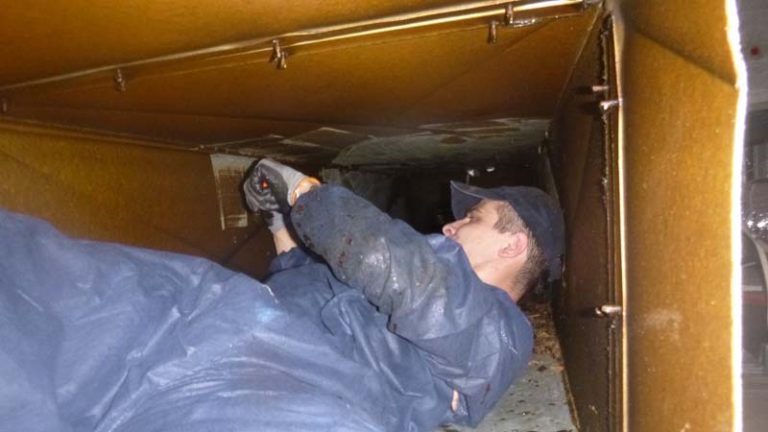Cleaning your exhaust ducts is essential for maintaining a safe and efficient restaurant or cafe.
The following 5 methods are often used to clean a greasy kitchen canopy and exhaust system:
- Manual method,
- Steam cleaning method,
- Rotary, mechanised brushing system method,
- Hot chemical foam method,
- High-pressure water method.
This blog post will detail the Manual Method. Clean Air Filtration use variations of the Manual method in almost all jobs.
We do not recommend that you clean your own restaurant or cafe exhaust system. Instead, use a professional cleaning company to do this for you as they will ensure you are compliant and safe.
To perform the Manual Method you will need to provide access to the inside of your ductwork. This will require that ‘access panels’ are installed along your ductwork. If you don’t have access panels then this raises questions about the last duct cleaning company you used.
Here are 7 steps for completing a Manual clean of the kitchen exhaust duct system.
Step 1: Gather your materials & complete the pre-cleaning process
Before begining, make sure you have the following materials ready:
- Safety goggles and gloves,
- Cloths, rags, soft brush, and scraping tools,
- Chemical cleaner suitable for duct cleaning,
- Non-flammable cleaning aids (avoid flammable solvents).
Step 2: Wear safety gear & protect the work space
Before commencing the cleaning process, ensure that all food products are removed from the area. Store in a suitable location that is specifically designated for food storage.
Whenever feasible, relocate all food preparation cookware and equipment away from the workspace area. This precaution helps minimize the risk of contamination.
Put on your Personael Protetive Equipment (PPE).
Step 3: Hand Scraping and Removal
Start by manually scraping away any deposits or buildup on the inside surface of the ductwork using a suitable tool. Be gentle to avoid damaging the ducts.
Use a cloth or rag to wipe the surface of the ductwork. This helps remove loose dirt and debris.
Step 4: Chemical Cleaning (if needed)
If heavy deposits are present and not easily removed by scraping or wiping, apply a suitable chemical cleaner to the affected areas.
Follow the manufacturer’s instructions for the chemical cleaner, including any recommended dilution ratios.
Allow the chemical cleaner to sit for the specified amount of time to soften or dissolve the deposits.
Step 5: Gentle Scrubbing
After the chemical cleaner has had time to work, use a soft brush or cloth to gently scrub the softened deposits.
Continue scrubbing until the deposits are loosened and can be easily wiped away.
Step 6: Wipe Clean
Using a clean cloth or rag, thoroughly wipe the surface of the ductwork to remove any remaining debris and chemical residue.
Step 7: Inspection
After cleaning, inspect the exhaust ducts to ensure that all deposits and residues have been removed. Pay special attention to corners and hard-to-reach areas.
Step 8: Dispose of Waste
Dispose of any waste materials, such as used cloths or cleaning agents, in accordance with local regulations.
Remember that the use of flammable solvents or other flammable cleaning aids is strictly prohibited, as they can pose a significant fire hazard. Always prioritize safety and take appropriate precautions when cleaning exhaust ducts.
By following these steps, you can maintain clean and safe exhaust ducts that promote better air quality and ventilation in your space.




